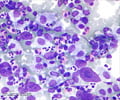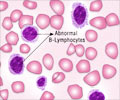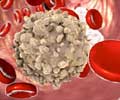AML - Classification
There are different types of leukemia, depending on the type of WBC they arise from and on the stages that these cells pass through as they mature.
Acute myeloid leukemia (AML), is also known as Acute Myelogenous Leukemia or Acute Myeloblastic Leukemia. AML is characterized by high levels of abnormal myelocytes or granulocytes that will never fully mature. In a healthy individual, the myeloblast is a precursor cell that gradually develops into a myelocyte, which is a type of WBC. These myeloblasts accumulate genetic mutations that prevents maturation and promotes uncontrolled division. The accumulation of these cells tend to affect the production of normal cells. If left untreated, AML could be fatal within a span of a few months.
AML is categorized as a diverse and heterogenous group of diseases based on the fact that leukemic transformations can occur anywhere along the differentiation pathway. Modern classification for AML acknowledge that the characteristics and behavior of the leukemic cell depends largely on the stage at which differentiation was stopped.
1. WHO classification
The World Health Organisation (WHO) classification of AML is clinically useful and produces more information that is relevant to prognosis.
- AML with characteristic genetic abnormalities: such as translocations between chromosome 8 and 21 [t(8;21], translocations between chromosome 15 and 17 [t(15;17)] and inversions involving chromosome 16 [inv(16)]. Patients belonging to this subtype have a high rate of remission and a better prognosis compared to the other subtypes.
- AML with multilineage dysplasia: This category includes patients who suffer from Myelodysplastic Syndrome (MDS) or Myeloproliferative Diseases (MPD) before eventually developing AML. This subtype occurs mostly in older patients and has a poor prognosis.
- AML and MDS, therapy-related: This category includes patients who have been subjected to chemotherapy and/or radiation and who subsequently develop AML or MDS. These leukemias are often characterized by specific chromosomal abnormalities, and are associated with poor prognosis.
- AML- not otherwise categorized:This category includes subtypes of AML that do not fall into the above categories.
- Acute leukemias of ambiguous lineage: Acute leukemias of ambiguous lineage (also known as mixed phenotype acute leukemia) are a subtype of Acute Leukemia where the leukemic cells can not be identified as either myeloid or lymphoid cells, or where both types of cells are present.
2. FAB classification
MO Acute myeloid leukaemia with very little evidence of myeloid differentiation
M1 Acute myeloblastic leukaemia without maturation
M2 Acute myeloblastic leukaemia with maturation
M3 Acute promyelocytic leukaemia (APL)
M4 Acute myelomonocytic leukaemia
M5 Acute monocytic/ monoblastic leukaemia
M6 Acute erythroleukaemia
M7 Acute megakaryoblastic leukaemia












